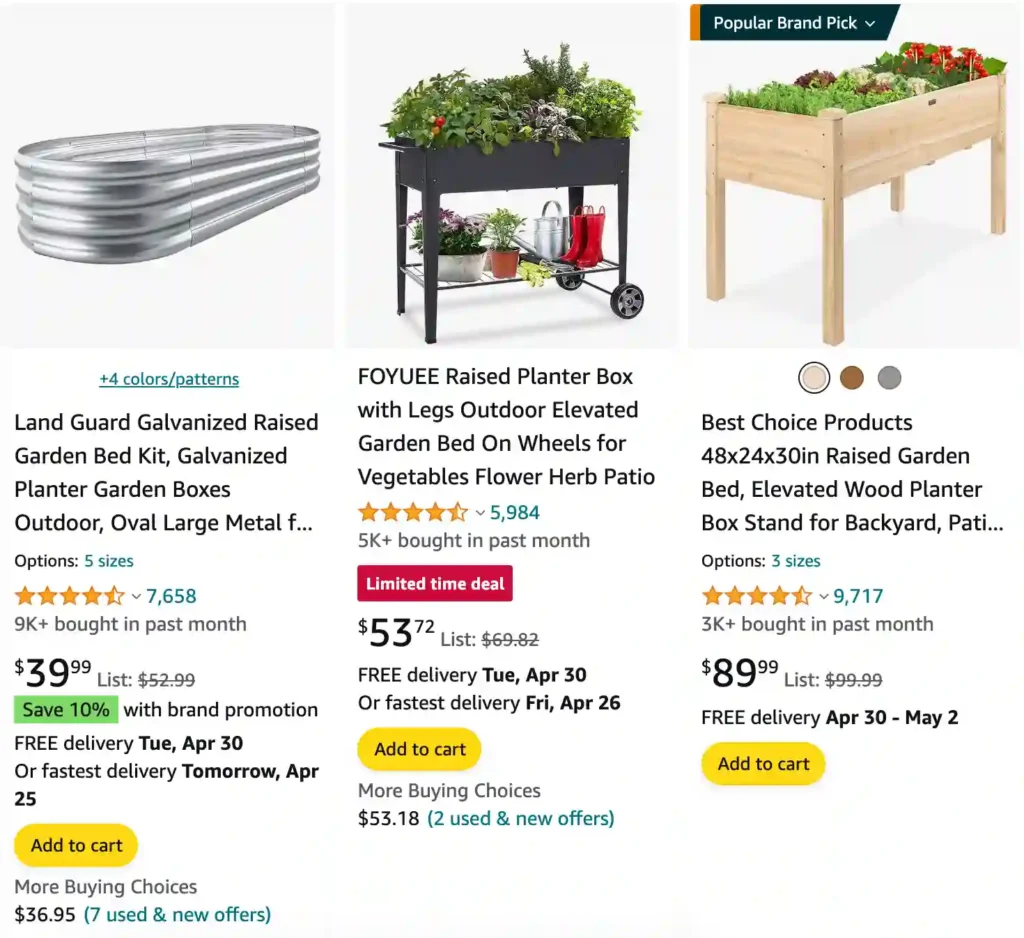
How to build a raised garden bed cheap?
Building my first raised garden bed on a budget was such an exciting project! I spent hours scouring the internet for ideas, and found the best way to save cash is to upcycle. My neighbor had some old pallets he was getting rid of, which were perfect for creating the walls of my raised bed. With a bit of elbow grease, some wood screws, and a lick of paint, they looked great! To line it, I used thick landscape fabric that was leftover from another project. Of course, the most important part, the nutrient-rich soil, was where I did need to spend a bit of money, but I knew that having a healthy base would give me the best chance at a flourishing garden.
How to build a raised garden bed with legs?
Building a raised garden bed with legs was a bit more ambitious than my first project, but it definitely felt like a level-up. I loved not having to bend down as much, and it kept pesky critters at bay better too. Finding those long 4×4 posts for the legs was the trickiest bit, but a local lumber yard had some offcuts that worked perfectly. Attaching the frame to those legs felt super satisfying, and I reinforced it with strong angled brackets for good measure. I even added a little shelf on the bottom between the legs – so convenient for storing my trowel and hand tools!
How tall should a raised garden bed be?
Honestly, the perfect raised garden bed height depends on what I’m growing and my own comfort level. For my leafy greens and herbs, a 12-inch bed is more than enough – those shallow roots don’t need much space. But I built a bed that’s almost up to my waist especially for my tomatoes. Those plants need room for serious root growth and I love that I can work on them without bending too much! Plus, I added a little bench nearby so when I do need to get closer to the ground, I can sit comfortably.
What to plant in a raised garden bed?
The possibilities with a raised garden bed seem endless, which can be a bit overwhelming at times! So far, I’ve had amazing success with herbs. Mint, basil, rosemary – they all thrive in a raised bed and I can pluck fresh leaves right outside my kitchen. Salad greens were another no-brainer, and it feels so rewarding harvesting spinach and arugula for a homegrown lunch. This year, I’m going to experiment a bit, with some climbing beans on a trellis, maybe some zucchini (if I can keep the squirrels away!), and definitely a gorgeous row of sunflowers!
Can you use treated wood for raised garden beds?
This whole treated wood debate has definitely given me pause over the years. I get why people want the longevity that treated wood provides, but the thought of potential chemicals leaching into my veggies isn’t something I’m comfortable with. I did some serious research, and though modern treated wood is considered safer than the old stuff, I decided there were alternatives I preferred. For most of my beds, I’ve used cedar, which is naturally rot-resistant and looks great. It’s a bit pricier, but for me, the peace of mind knowing my food is 100% chemical-free makes it worth it.
How deep does a raised garden bed need to be?
The depth of my raised garden beds varies depending on what I want to grow. For shallow-rooted plants like lettuce, radishes, or even strawberries, I’ve gotten away with just 6-8 inches of soil That gives them enough space to establish a healthy root system. But when it comes to my tomatoes, peppers, or anything with deeper roots, I go for at least 12 inches, sometimes even a bit more. It’s amazing to see how much those plants benefit from the extra room, producing bigger and more abundant veggies!
How often to water vegetable garden raised bed?
Watering my raised beds is a bit of a balancing act. I’ve learned the hard way that overwatering is just as bad as underwatering! The best method for me is feeling the soil. I stick my finger about an inch or two down – if it feels dry, it’s time for a good, deep soak. Sometimes that’s every day during a hot spell, but I might go a few days during cooler weather or after a rainstorm. My plants are my best guide – if they start looking wilted, I know it’s time to water, no matter what the schedule says.
How to winterize raised garden beds?
Where I live, we don’t have super harsh winters, but I still take the time to winterize my raised beds. After I harvest the last of my fall crops, I pull any remaining weeds and add a layer of compost or aged manure to replenish the nutrients. Then, a thick layer of mulch goes on top. I like using shredded leaves because they’re free and abundant in my yard, but straw or wood chips work great too. This helps insulate the soil during cold snaps and also suppresses any pesky weeds that might pop up in the early spring.
How to build a raised garden bed with concrete blocks?
Building a raised bed with concrete blocks was a game-changer for me! I love their no-nonsense look and incredible durability. Plus, finding them used on a local marketplace made this a super affordable project. The hardest part was leveling the ground since my yard has a slight slope. After that, it was like putting together giant LEGOs! I staggered the blocks for a stronger structure and made sure to fill the holes with soil too – perfect spots to tuck in herbs or flowers that cascade down the sides.
How to cover a raised garden bed?
I use covers on my raised beds for all sorts of reasons! During spring, a lightweight row cover over my beds helps protect my seedlings from those unpredictable frosts and creates a cozy microclimate for faster growth. Once summer really hits, switching to bird netting keeps those thieving critters from enjoying my veggies before I can! In the fall, when the weather gets cooler, I put those row covers back on to extend my growing season just a bit longer. Having all these options feels like I’m cheating the seasons!
How to get rid of ants in raised garden bed?
Dealing with ants in my raised garden beds is an ongoing battle! I try to stay as organic as possible with control methods because I don’t want to put harsh chemicals anywhere near my food. Diatomaceous earth has been my go-to – sprinkling a circle of that stuff around the bed seems to deter the little critters. Another trick is to find their nest nearby. Sometimes a blast of boiling water is enough to make them pack up and relocate. However, if their colony is really persistent, I’ve had to resort to those little borax ant traps. I place them well away from my beds, but the ants always seem to find them!
How to level a raised garden bed?
Leveling my raised garden beds might just be my least favorite part of the whole process! But I know it’s important, otherwise I end up with uneven watering and potential issues with the frame of the bed itself. My yard has some natural slope to it, so finding the perfect spot is always step one. After that, it’s a process of digging out high spots, filling in low ones, and lots of checking with a level! It’s a little tedious but seeing that perfectly level bed in the end makes all the effort worthwhile.
How much soil for raised garden bed?
Figuring out exactly how much soil to buy for my raised beds always makes me feel slightly panicky! I don’t want to run out mid-fill, but I also hate the idea of wasting money on soil I don’t need. Thankfully, there are great online calculators that make it super easy. I measure the length, width, and depth of my beds, plug those numbers in, and then add a little bit extra–just in case. For my first beds, getting the hang of how densely soil packs in was tricky, so now I know to always overestimate a bit!
Should i line my raised garden bed?
I go back and forth on lining my raised garden beds. Sometimes I do, especially when I’m using new wood that I’m worried might seep chemicals or have rough edges that could damage the roots of my plants. A thick landscape fabric is my go-to liner. However, for established beds, or those made from cedar, I often skip the liner. I like the idea of beneficial worms and microorganisms moving freely between the bed and the surrounding soil. Ultimately, it’s a decision I make on a bed-by-bed basis.
Can i put grass clippings in my raised garden bed?
Absolutely! I always throw some grass clippings into my raised beds. A thin layer mulches around my plants, helping to keep the soil moist, suppress weeds, and prevent erosion. They also add a nice dose of nitrogen as they break down, which is an added bonus. My only word of caution is to make sure the lawn hasn’t been treated with herbicides or pesticides before collecting those clippings – I want to keep things as organic as possible in my veggie beds!
Can rabbits jump into raised garden beds?
Sadly, I found out the hard way that rabbits are incredible jumpers! I thought my first 12-inch raised beds would be enough to keep them out, but I was wrong. Those furry thieves feasted on my tender lettuce and young beans. Nowadays, I go for 24 inches as a minimum height, and even higher for larger critters if they’re a problem in my area. During peak rabbit season, a little temporary fencing or netting might be necessary for extra peace of mind.
Do raised garden beds need drainage?
Absolutely! Proper drainage is essential for my raised garden beds. Even though they’re raised, that doesn’t mean water can magically disappear. If there’s no way for excess moisture to escape, I can end up with waterlogged soil, root rot, and unhappy plants. For beds with solid bottoms, I drill a few drainage holes. I also always layer the bottom of my beds with a bit of coarse material, like small rocks or broken-up terracotta, before adding my soil – this helps get water moving away from my plant roots.
How to grow potatoes in a raised garden bed?
Growing potatoes in my raised bed is one of my favorite gardening projects! It always feels a little magical to harvest a whole heap of spuds from what started as tiny “seed potatoes.” The key for me is light, fluffy soil. I mix in loads of compost to make it nice and nutrient-rich. Then I plant my seed potatoes about 6 inches deep and as they grow, I keep “hilling up” soil around the stems. This encourages more potatoes to form along the buried stems. It’s so satisfying to go digging for those potato treasures when harvest time comes!
How to keep dogs out of raised garden beds?
Keeping my enthusiastic dogs out of my raised garden beds has been a learning process! At first, I tried simple barriers like sticks or overturned flower pots around my vulnerable seedlings, with mixed success. For beds that are closer to the ground, creating a wide perimeter of mulch with rough textures seemed to deter their curious paws. With my higher beds, simple verbal commands and lots of positive reinforcement helped. Now, they’ve mostly learned that the raised beds are off-limits, but I still keep a watchful eye during those extra playful moments!
How to keep groundhogs out of raised garden beds?
Battling groundhogs over my raised beds has felt like an epic war! I’ve tried so many tactics to keep those hungry critters away. Fencing is essential. I’ve got strong, high fencing around my main garden area, buried at least a foot deep to deter burrowing. Motion-activated sprinklers have also helped—getting blasted with water seems to startle them enough to change their minds about a snack. I’ve heard mixed opinions on repellents, but scattering something spicy (like cayenne pepper) on the beds’ edges seems to provide some temporary protection.
How to layer soil in a raised garden bed?
Layering soil in my raised garden beds is a bit of an art form for me! I love the idea of creating the most nutritious and efficient growing environment for my plants. Sometimes, I use what’s called the “Hugelkultur” method. This involves layering branches and logs on the very bottom, which break down over time adding nutrients and holding water. Then, I’ll add layers of compost, leaves, and other organic material. The final layer is always a good quality topsoil for my plants to root into. It takes a little planning, but I see a noticeable difference in the health of my plants grown in these layered beds!
How to repair raised garden bed?
How I repair my raised beds depends on the damage. Rotting wood is the most common issue I run into. If it’s just a small section of a board, sometimes I can cut out the bad part and sister in a new piece of wood for support. For more extensive rot, I might have to replace the whole board. Loose screws are an easy fix, but if the corners of a bed are bowing out, it might need reinforcement with some heavy-duty brackets. It’s frustrating when a bed starts to fail, but I’ve learned a lot from these DIY fixes!
How to trellis cucumbers in a raised garden bed?
I love trellising my cucumbers in my raised garden beds – it saves space and makes harvesting so much easier! I’ve used a few different methods over the years. My favorite for stand-alone beds involves building simple A-frame trellises out of sturdy wood or bamboo poles. I position them right in the bed and train my cucumber vines to climb up. For beds that are against a fence or shed, I often attach cattle paneling. It’s inexpensive, incredibly strong, and perfect for those vigorous vines to grab onto.
Are metal raised garden beds safe?
The whole metal raised bed safety debate has definitely made me think twice. Of course, food-grade metals like galvanized steel or stainless steel are the safest choices. But there’s still that potential concern about heat – metal heats up in the sun much faster than wood. I use my metal beds strategically, mostly for early season crops that thrive in those slightly warmer conditions. If the weather gets scorching, I might add some shade cloth to protect sensitive plants. I think a bit of common sense and mindful planting go a long way in making metal beds safe and productive!
Can i use railroad ties for raised garden beds?
While the classic look of railroad ties might be appealing, the idea of using them in my raised garden beds makes me uneasy. I’ve done the research, and the general consensus is that they’re just not worth the risk. Railroad ties are saturated with creosote, a preservative that contains potential carcinogens. Although the risk from older, weathered ties may be lower, I’m not willing to take that chance on food I plan to eat. There are so many safer and healthier alternatives out there, I’d rather opt for something that gives me total peace of mind.
Can you paint raised garden beds?
Yes, you absolutely can paint raised garden beds! It’s a fantastic way to add a pop of color to my garden or match my backyard aesthetic. However, choosing the right paint is absolutely essential. I always look for a non-toxic, exterior-grade paint that’s safe for use around plants. Sealing the wood before painting is a good idea too, especially for new beds. I love the playful look of painted beds, and with proper preparation, I feel confident that it’s a safe way to personalize my garden space.
Can you use cedar for raised garden beds?
Absolutely! Cedar is one of my favorite choices for raised garden beds. Its natural rot resistance makes it super durable, even when exposed to the elements. Plus, I love the warm, natural look, and there’s no need to worry about any questionable chemicals potentially leaching into my soil. Cedar can get expensive, so I don’t use it for every bed, but when building something I want to last for years, I think it’s a worthwhile investment.
Can you use mulch in a raised garden bed?
I definitely use mulch in my raised garden beds! It offers a host of benefits that make my gardening life easier. My favorite reason is that it suppresses weeds. A good layer of mulch makes it much harder for those pesky plants to get started. Mulch also helps the soil retain moisture, so I don’t have to water as often. As organic mulches like wood chips or leaves break down, they improve the soil too. My only consideration is the size of my bed and the depth of the mulch layer – I don’t want to totally smother my plants!
Can you use pine for raised garden beds?
You can use pine for raised garden beds, but it comes with a few caveats. It’s a readily available and affordable wood, making it a tempting choice. However, untreated pine isn’t naturally rot-resistant so it will break down much faster than options like cedar or redwood. If budget is my primary concern, sometimes I’ll use pine knowing I’ll need to replace the beds after a few years. Lining it with landscape fabric, painting it with a protective sealant, or using it for shorter-season plantings are some tricks I use to prolong the life of my pine beds.
How to move a raised garden bed?
Moving a raised bed depends on its size, materials, and whether I want to keep the soil intact. For small, lightweight beds, emptying the soil first is the easiest approach. I can usually tip them on their side and drag them to the new location. Heavier, larger beds might need a few strong friends to help lift and carry. If I want to keep the soil and plants undisturbed, it gets trickier. Sometimes sliding a large piece of plywood under the bed can work, or creating a makeshift dolly can make things more manageable. It’s a matter of figuring out the most practical approach based on the specific bed!
How to refresh raised garden bed soil?
I make refreshing my raised bed soil an annual springtime ritual! After removing any old plant debris from the previous season, my focus is on restoring nutrients. A big dose of compost is my go-to – it feeds my soil with beneficial microbes as well as organic matter. I like to add in some other amendments too, depending on what I plan to plant – things like worm castings, bone meal, or kelp meal give my veggies an incredible boost. Finally, I top everything off with a fresh layer of topsoil, giving my plants the perfect environment to thrive!
If i die, water my plants!



